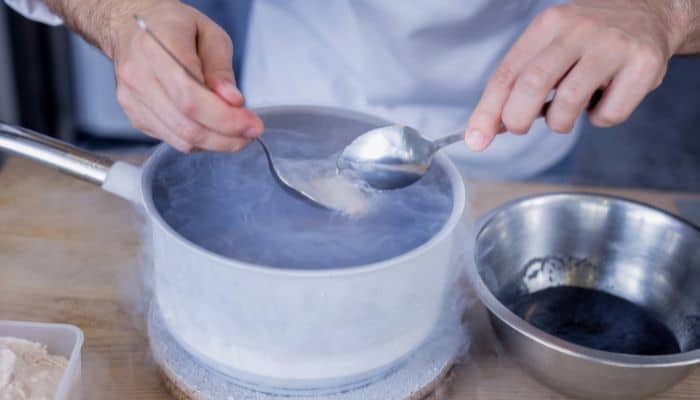Pros and Cons of Dry Cooking Methods
Have you ever reflected on the many interdependent factors that combine to create your favorite meal? It isn’t only the ingredients you choose but the cooking method and timing that synthesizes everything to create a masterpiece that’s much yummier than the sum of its parts.
Cooking methods can change the entire character of a dish — bacon would be much different if you boiled it. Each technique has its benefits and downsides. It ultimately comes down to the dining experience you want to create. Let’s explore the pros and cons of various dry cooking methods.
What, Exactly Is “Dry Cooking?”
Dry cooking simply means heating food without the assistance of a liquid — including water, juice or wine. Frying is a finer line but is technically considered a dry cooking method by chefs, perhaps because the original fats used, like lard and butter, are solid at room temperature. Today, vegetable oils are more widely used for their health benefits, although some believe they may increase inflammation in people with chronic diseases.
General Benefits of Dry Cooking
All dry cooking methods provide certain benefits:
- Emphasize ingredient flavor: Moisture pulls nutrients and tastes out of foods, which is desirable when making a broth or sauce. However, dry cooking traps them inside, which is why people often minimize marinades on steaks and roasts to let the meat sparkle.
- Preserve texture: Could you imagine chewing boiled bacon? Dry cooking preserves the texture of meat and plant-based dishes.
- Cook quickly with fewer ingredients: If you have a fire and a fish, you can have a quick, protein-rich meal with minimal fuss. In general, dry cooking methods take less time than wet.
A Deeper Look at the Benefits of 8 Dry Cooking Methods
Here are some of the most popular dry cooking methods you probably already use in your kitchen. Let’s take a closer look at the unique benefits and downsides of each.
1. Grilling
Grilling is among the most primitive cooking methods. It transfers heat from below, cooking your food through thermal radiation over grills or a special pan with raised ridges to mimic an open grill’s wires.
The biggest benefit of grilling, outside of cooking time, is fat reduction. Much of the fat from meats drips away, reducing your overall intake.
2. Frying and Deep-Frying
Frying is a dry cooking method that involves cooking food in a generous quantity of fat to create a crispy texture. Traditional methods use a stove-top pan, partially immersing your meal, whereas deep-frying involves completely submerging the food in fat until it is fully covered.
Once upon a time, the benefit of this method was increasing the calorie-rich fat content of dishes to help people survive long, cold winters when meals were scarce. However, this perk has become a downside today, as abundant year-round food supplies have reduced the need for people to participate in the human equivalent of “fat bear week.” Today, it’s best to enjoy such treats in moderation, as much as our taste buds still crave them.
3. Sauteing and Stir-Frying
The difference between frying, stir-frying and sauteing revolves around the amount of oil used to perfect food texture. Sauteing uses a much smaller amount of oil and takes longer. Chefs use it for high-moisture foods like mushrooms and onions. Stir-frying uses even less oil, typically peanut or sunflower, to cook chopped meats and vegetables quickly. The benefits include reducing oil use — for example, stir-fried chicken has fewer calories per ounce than a fried leg.
4. Air Frying
Air frying uses convection heat to cook foods. It’s ideal for reducing fat content, as it requires no external oils. It also retains the crisp taste of foods like french fries while preserving a moist interior. For the best homemade fries, try slicing and boiling your potatoes before air-frying them for an unbelievable texture.
5. Semi-Vacuum Cooking
Semi-vacuum cooking uses specialty cookware to preserve up to 93% of the nutrients in your food that can get lost through other dry cooking methods. It cooks faster as it uses higher temperatures and a vapor-locking lid that lets steam escape at the precisely right time. It involves specialty stainless steel cookware to heat food from all sides — a kind of high-tech convection style.
6. Roasting
Roasting involves using radiant thermal heat to cook food from all sides. In primitive days, people constructed ground ovens, placing haunches, vegetables and herbs together in a pit lined with fire-warmed stones.
Today, folks pop their favorite meal into a baking dish and place it in the oven. It’s similar to baking but uses higher temperatures, making foods cook faster. However, slow roasting provides more time for the fats in meats to melt and absorb into the surrounding tissue, resulting in a more flavorful meal.
7. Baking
Baking is essentially the same as roasting, only performed at lower temperatures. Like roasting, it surrounds your meal with radiant heat, generally from the top and bottom in modern ovens. Lower temperatures allow you to cook large dishes, like casseroles, that can otherwise burn on the outside while remaining cold inside, making it perfect for large meals or dishes with multiple ingredients that must blend, like bread.
8. Broiling
You might think of broiling as the opposite of grilling, at least in terms of the heat source. Broiling involves thermal radiation from above. In general, folks use it to add a nice char to already-cooked meals, as the high temperatures would otherwise dry out a part of the dish while leaving the rest uncooked. However, chefs also use it for lean, thin meats, such as broiled Alaskan halibut.
Which of These Dry Cooking Methods Is Right for Dinner?
Dry cooking methods offer various benefits. They’re traditionally used for certain meals, although you can feel free to go wild, experimenting with different techniques — air-fried hot dogs, anyone?
Play with these techniques. Once you master these dry cooking methods, you can use them to expand your creativity in the kitchen.



Comments are closed.